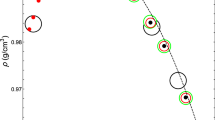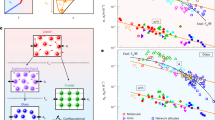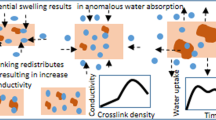Abstract
BY condensing water vapour into glass and quartz capillaries at reduced pressures, several groups1–4 have obtained small amounts of a substance which seems to contain only the constituents of water. It displays physical properties which differ markedly from those of water and so has been called “anomalous water”. Suggestions that this substance is in fact an oligomer5 or polymer4 have appeared since the publication of the original observations, and several hypothetical structures3–6 have been put forward. The stability of “anomalous water” is attributed to the existence of a heretofore unobserved type of chemical bond between water molecules of the type O′HO″ (if the bond is asymmetric, the hydrogen atom is more closely bound to O′). The energy of the bond is an order of magnitude greater than that of currently recognized hydrogen bonds. My purpose here is to report on calculations which call into serious question the existence of the proposed strong OHO bond and, consequently, polymeric structures based on it.
This is a preview of subscription content, access via your institution
Access options
Subscribe to this journal
Receive 51 print issues and online access
$199.00 per year
only $3.90 per issue
Buy this article
- Purchase on Springer Link
- Instant access to full article PDF
Prices may be subject to local taxes which are calculated during checkout
Similar content being viewed by others
References
Deryagin, B. V., Talaev, M. V., and Fedyakin, N. N., Proc. Acad. Sci. USSR Phys. Chem., 165, 807 (1965).
Willis, E., Rennie, G. R., Smart, C., and Pethica, B. A., Nature, 222, 159 (1969).
Bellamy, L. J., Osborn, A. R., Lippincott, E. R., and Bandy, A. R., Chem. Ind., 686 (1969).
Lippincott, E. R., Stromberg, R. R., Grant, W. H., and Cessac, G. L., Science, 164, 1482 (1969).
Bolander, R. W., Kassner, J. L., and Zung, J. T., Nature, 221, 1233 (1969).
Donohue, J., Science, 166, 1000 (1969).
Rein, R., Fukuda, N., Win, H., Clarke, G. A., and Harris, F. E., J. Chem. Phys., 45, 4743 (1966).
Rein, R., Clarke, G. A., and Harris, F. E., J. Mol. Struct., 2, 103 (1968).
Benedict, W. S., Gailar, N., and Plyler, E. K., J. Chem. Phys., 24, 1139 (1956).
Giguere, P. A., Bull. Chem. Soc. France, 21, 720 (1954).
Author information
Authors and Affiliations
Rights and permissions
About this article
Cite this article
MINTON, A. Can Water Polymerize ? An Inquiry into the Possible Existence of Strong Bonds between Water Molecules. Nature 226, 151–152 (1970). https://doi.org/10.1038/226151a0
Received:
Issue Date:
DOI: https://doi.org/10.1038/226151a0
This article is cited by
-
Foreword to the biophysics of protein-protein and protein-ligand interactions in dilute and crowded media—a special issue in honor of Allen Minton’s 70th birthday
Biophysical Reviews (2013)
-
A review of the preparation and properties of anomalous water
Matériaux et Constructions (1971)
Comments
By submitting a comment you agree to abide by our Terms and Community Guidelines. If you find something abusive or that does not comply with our terms or guidelines please flag it as inappropriate.



